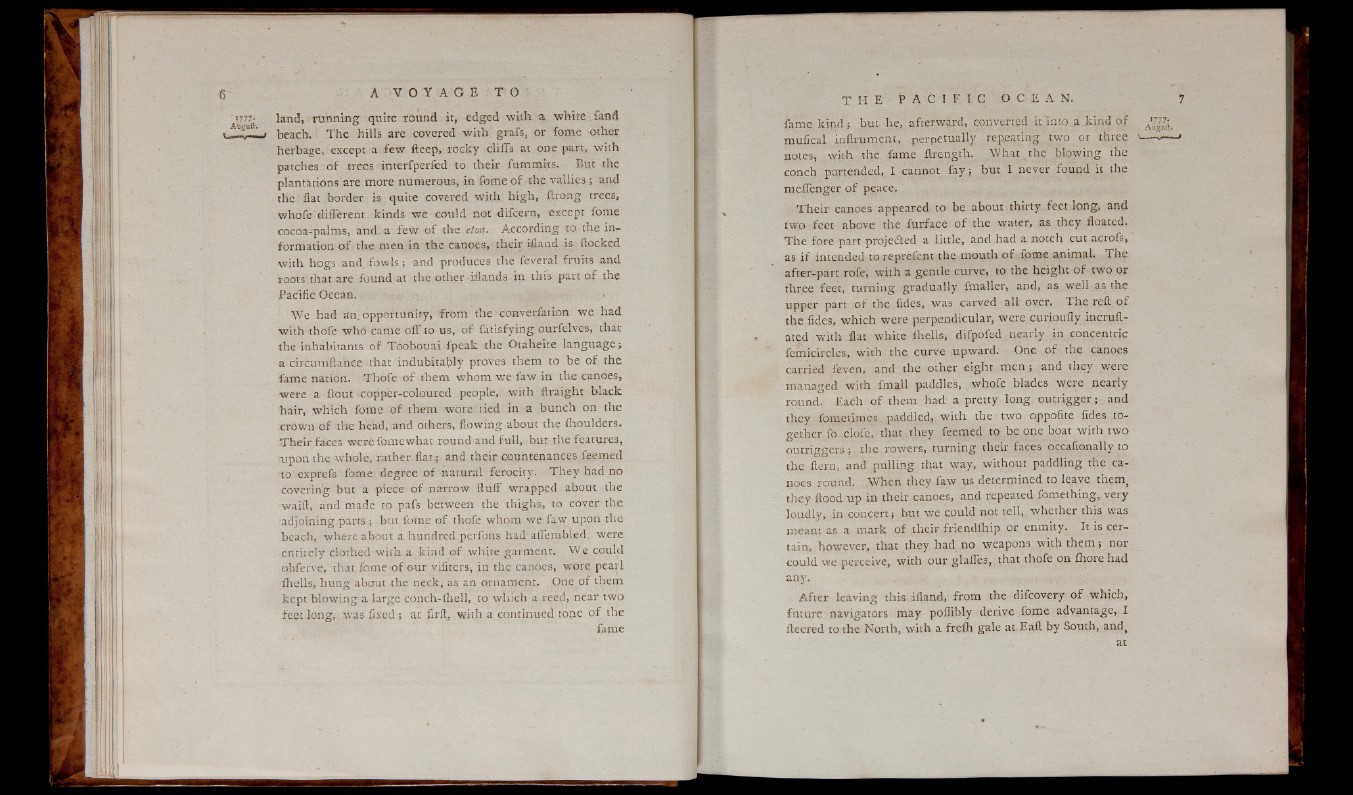
' 1777' land, ru nn in g quite round it, edged w ith a w hite fand
■_A°-g— ■ beach. T he hills are covered w ith grafs, or fome other
herbage, except a few fteep, rock y cliffs at one part, with
patches o f trees interfperfed to their fummits. But the
plantations are more numerous, in fome o f the vallies ; and
the flat border is quite covered with h igh , ftrong trees,
whofe different kinds we could not difcern, except fome
cocoa-ipalms, and. a few o f the etoa. According to the information
o f the men in the canoes, their ifland is flocked
w ith hogs and fowls ; and produces the feveral fru its and
roots that are found at the other iflands in this part o f the
Pacific Ocean.
We had an. opportunity, from the converfation w e had
w ith thofe whO came o ff to us, o f fa tis fy in g ourfelves, that
the inhabitants o f Toobouai fpeak the Otaheite la n g u a g e ;
a circumftanee that indubitably proves them to be o f the
fame nation. Thofe o f them whom we faw in the canoes,
were a flout copper-coloured people, with flraight bla ck
hair, w hich fome o f them wore tied in a bunch on the
crown o f the head, and orhers, flowin g about the fhoulders.
T h e ir faces were fomewhat round and fu ll, but the features,
upon the whole, rather flat; and their countenances feemed
to exprefs fome degree o f natural ferocity. T h e y had no
covering but a piece o f narrow flu ff wrapped about the
waift, and made to pafs between the th igh s , to cover the
adjoining parts j but fome o f thofe whom w e faw upon the
beach, where about a hundred perfons had affembled, were
entirely clothed with a kind o f white garment. W e could
obferve, that fome o f our.'vifiters, in the canoes, wore pearl
ihells, hu ng about the neck, as an ornament. One o f them
kept blowing a large conch-{hell, to which a reed, near two
feet lo n g , was fixed ; at firft, with a continued tone o f the
fame
fame k in d ; but he, afterward, converted i t 'in to a kind o f
mufical inftrumenr, perpetually repeating two or three
notes, w ith the fame ftrength. What the b lowin g the
conch portended, I cannot f a y ; bu t I never found it the
meifenger o f peace.
T h e ir canoes appeared to be about thirty feet long, and
two feet above the furface o f the water, as they floated.
T h e fore part projedled a little, and had a notch cut acrofs,
as i f intended to reprefent the mouth o f fome animal. The
after-part rofe, w ith a gentle curve, to the height o f two or
three feet, turnin g grad ually fmaller, and, as well as the
upper part o f the fides, was carved all over. T h e reft o f
the fides, which were perpendicular, were curioufly incruft-
ated w ith flat white ihells, difpofed nearly in concentric
femicircles, with the curve upward. One .of" the canoes
carried feven, and the other eight men ; and they were
managed with fmall paddles, whofe blades were nearly
round. Each o f them had a pretty long o u t r ig g e r ; and
they fometimes paddled, w ith the two oppofite fides together
fo clofe, that they feemed to be one boat w ith two
o u t r ig g e r s ; the rowers, turning their faces occafionally to
the item, and p u llin g that way , without paddling the canoes
round. ,When they faw us determined to leave thema
they flood up in their canoes, and repeated fomething, v e ty
loudly, in con ce r t; but w e could not tell, wliethei this was
meant as a m a rk o f their friendfhip or enmity. It is certain,
however, that they had no weapons with th em ; nor
could we perceive, with our glafles, that thofe on fhorehad
any.
A fte r lea vin g this ifland, from the difcovery o f which,
future navigators may poflibly derive fome advantage, I
fleered to the North, with a frefh gale at Eaft by South, and5
at